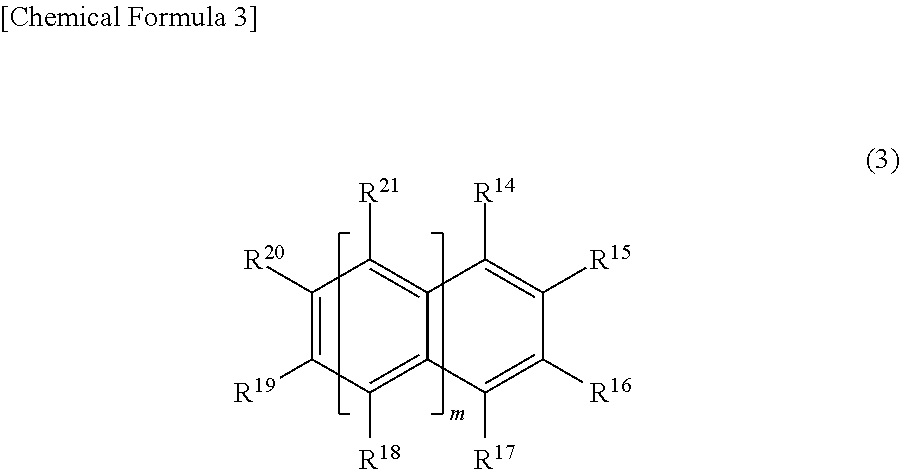Method of production of radial conjugated diene polymer
- Summary
- Abstract
- Description
- Claims
- Application Information
AI Technical Summary
Benefits of technology
Problems solved by technology
Method used
Image
Examples
reference example 1
Synthesis of p-Methylstyrene Oligomer
[0086]Under a nitrogen atmosphere, a glass reaction vessel equipped with a magnetic stirrer was charged with 48.0 parts of cyclohexane and 1.13 parts of p-methylstyrene. Next, while stirring, 0.0615 part of sec-butyl lithium was added and the mixture was polymerized at a polymerization temperature of 40° C. for 1 hour while stirring. A small amount of methanol was used to stop the polymerization reaction, pure water was used to extract and wash the catalyst residue, then the solvent was distilled off to thereby obtain 1.12 parts of the target oligomer of p-methylstyrene. The obtained oligomer of the p-methylstyrene had an Mn of 1,280, an Mw of 1,440, a molecular weight distribution (Mw / Mn) of 1.13, and an average polymerization degree found from the value of Mn of 10.8.
example 1
Lithiation of p-Methylstyrene Oligomer and Polymerization of Isoprene by Lithiated p-Methylstyrene Oligomer
[0087]Under a nitrogen atmosphere, a glass reaction vessel equipped with a magnetic stirrer was charged with 2.81 parts of cyclohexane, 0.284 part of the oligomer of p-methylstyrene obtained at Reference Example 1, and 0.279 part of tetramethylethylenediamine. Next, while stirring, 0.154 part of sec-butyl lithium (1.0 mol of tetramethylethylenediamine per 1 mol of sec-butyl lithium) was added and the mixture was reacted at a reaction temperature of 20° C. for 40 minutes while stirring. Next, 18.7 parts of benzene and 3.00 parts of isoprene were added and the mixture was polymerized at a polymerization temperature of 40° C. for 2 hours while stirring. A small amount of methanol was used to stop the polymerization reaction, pure water was used to extract and wash the catalyst residue, then the solvent was distilled off to thereby obtain 3.26 parts of the target polyisoprene. The ...
reference example 2
Lithiation of 1,3,5-Trimethylbenzene and Measurement of Lithiation Rate—1
[0088]Under a nitrogen atmosphere, a glass reaction vessel was charged with 12 parts of cyclohexane, 0.144 part of 1,3,5-trimethylbenzene, and 0.460 part of tetramethylethylenediamine. Next, while stirring, 0.230 part of n-butyl lithium (1.1 mol of tetramethylethylenediamine per 1 mol of n-butyl lithium) was added and the mixture was allowed to stand at a reaction temperature of 20° C. for 3 days for a reaction. Next, to measure the Lithiation rate of the lithiated 1,3,5-trimethylbenzene which was obtained by the reaction, several drops of the obtained reaction solution were added to a glass vessel to which an excess amount of trimethylsilyl chloride was added and the mixture was allowed to react for 30 minutes. Tapwater was used to extract and wash the catalyst residue, then the solvent was distilled off to obtain a yellow oily liquid. This yellow oily liquid was measured by gas chromatograph mass spectroscopy...
PUM
| Property | Measurement | Unit |
|---|---|---|
| Substance count | aaaaa | aaaaa |
| Substance count | aaaaa | aaaaa |
| Substance count | aaaaa | aaaaa |
Abstract
Description
Claims
Application Information
 Login to View More
Login to View More - R&D
- Intellectual Property
- Life Sciences
- Materials
- Tech Scout
- Unparalleled Data Quality
- Higher Quality Content
- 60% Fewer Hallucinations
Browse by: Latest US Patents, China's latest patents, Technical Efficacy Thesaurus, Application Domain, Technology Topic, Popular Technical Reports.
© 2025 PatSnap. All rights reserved.Legal|Privacy policy|Modern Slavery Act Transparency Statement|Sitemap|About US| Contact US: help@patsnap.com



